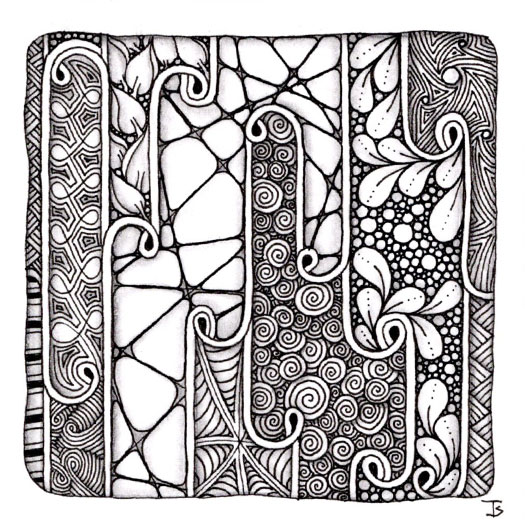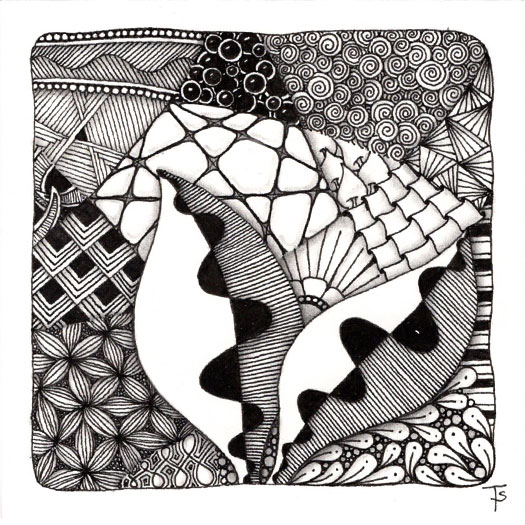It’s been a while since I’ve done a meditative Zentangle. I took the time for this one because I was having one of “those days”. The Zentangle method is a great technique for setting aside all of the outside world noise and just relaxing and drawing for a bit.
Give it a try!
Zentangle drawn on Strathmore Vellum Bristol using a black, Micron pen. Shading done with graphite pencil.
Melting Mooka, introduced to us by Zentangle's Project Pack #6 , is a wonderful version of Mooka that can be used to as a string to divide a tile into smaller spaces.
These internal sections, when filled with other tangles, result in a tile that gives the impression of stained glass windows.
This was a fun, playful exercise!
Zentangle drawn on Strathmore Vellum Bristol using a black, Micron pen. Shading done with graphite pencil.
Generally, now days, I use fewer tangles on a tile that I did when I began 10 years ago. But not always.
Yesterday, I decided to create a complex string and use a lot of different tangles. I had been looking through tiles from years ago and I wanted to see if I could still tangle in that style.
It took longer to choose the tangles than it did to draw them! 17 tangles is a LOT!
This tile was created following the instructions from Eni Oken ’s Art Club ’s latest lesson, Glazed Whitework .
It all started with a watercolor tile. It was an interesting challenge to draw the string and all of the tangles using a white colored pencil. Then more color was added creating the depth and shading you see here.
One of the most challenging things was to select appropriate tangles. It’s much more difficult to create detail with colored pencils than if you were using an inking pen.
My random tanglizer spit out a lot of tangles for practicing line work yesterday. At first, I was a bit worried that these wouldn’t produce enough contrast. But after using my magic wand (actually, a pencil), I like the way they became distinct and unique!
Zentangle drawn on Strathmore Vellum Bristol using a black, Micron pen. Shading done with graphite pencil.
Tangles: Fassett Flux Fracas Nzepple Sand Swirl Static Tipple Xircus
This tile is the result of an ongoing challenge (#TangleTagCZT30) on the Zentangle Mosaic app . Each person is to create a tile using all of the tangles that came from previous CZTs in the chain, and add one more of their own choosing.
There were seven people in the chain when I was tagged. I’ve added the eighth tangle, Zailz.
I found this interesting, and very challenging. This was a lot of different tangles to try and fit on a single Zentangle and still have anything that wasn’t total chaos!
Amanda created this tile with the help of her family! She has four children that range in age from 7 to 17 years old.
She started by creating the string and then, each child would roll a dice and select a random tangle. The child would also choose where the tangle would go in the string.
The kids got a big kick out of challenging Mom, and they had a ton of fun. In addition, the final Zentangle came out great!
I think we’ve found a special dimension that warps time and space. As we go along for the ride, the plants along the side of the path start poking through here and there to remind us of where we’re going.
Zentangle drawn on an Official Zentangle tile using a black, Micron pen. Shading done with graphite pencil. Highlights done with white colored pencil.
Tangles: Flux Striping
Caution.
The stinging pods were almost hidden against the background design. Only their vibrating movement gave them away when she looked carefully. She was so glad that she noticed them before they paralyzed her!
Zentangle drawn on Strathmore Vellum Bristol using a black, Micron pen. Shading done with graphite pencil. Pastel pencil highlights.
Tangles: Antidots Canard Flux Zinger
Interwoven.
Everything in their lives was interwoven. No single thing could exist without the other. Each element fed the whole.
Crazy Huggins is a wonderful example of single elements combining to make a complete design. In this version, I used a fair amount of shading to add additional dimension to each decorated section. I also used a heavier line weight around the outside to define each section and a finer width pen for the decorative elements. All of these things together create a more graphic finished tile.
This tile uses a basic technique referred to as a Zenbutton. CZT Marguerite Samama is credited as the inventor of this technique. She was experimenting with methods for using Fragments in different ways when she discovered it.
You can watch an instructional video, created by Melinda Barlow, CZT, here , to see the basic technique.
I’ve been thinking about trying it for a few days. Yesterday, I sat down and went for it. For my first attempt, I’m very happy with the results. I will definitely add this to my tangle enhancing techniques!
This tile was done by Amanda. I absolutely love it. She decided to experiment with having both a light and a dark background on the same tile, and I think it worked really well. I love the way it shows off the white “ribbons” of tangles on top of the dark areas. I am also super impressed by the intertwining of all the elements!
Zentangle drawn on Strathmore Vellum Bristol using a black, Micron pen and white, Sakura Gelly Roll pen. Black area colored with a Sakura Identi-Pen. Shading done with graphite pencil and white chalk pencil.
This wonderful tile was created by my daughter. She is my student and protégé! She is such an amazing artist and she loves to be my class tester. It never ceases to amaze me what she will do and whether she will change something because she likes her way better. I’m so proud of her and so happy we will both become CZTs at the same seminar!
She saw my similar tile and asked me to teach her how to do it. It’s always a great opportunity for me to have a “practice student!” And it’s so much fun to work together.
Choice.
She looked down at the floor and realized that there were so many choices, all woven together, that could make up the whole. While each one was different they were all part of the fabric of her life.
So far this year, I’ve done very few “regular” Zentangles. When I completed this one, and showed it to my daughter, she asked me, " Does it feel weird to do black and white now?" That was an interesting question because it was something that I was actually thinking about when I did it! And, the answer was, “Yes, it is a bit strange because I’ve been moving so far away from it lately.”
This is my own design, done in the Tints on Tan style. I wanted to finish out the week of beach-themed tiles with something original! After looking at pictures of sea horses, I realized their bodies are basically made up of a bumpy grid. Once I got that, the rest was easy!
I didn’t add any wave foam or sand dots because this one is actually meant to be under water.
This is the final, official tile for the Tints on Tan, beach series.
These tiles, combining colored pencil and tangling have been so much fun to do. Technically, these would be considered ZIAs (Zentangle Inspired Art) rather than standard Zentangles. However, if you like this type of thing, they can be just as “zen” and relaxing to do. I particularly like the subject matter because the ocean reminds of of summer and vacations, happy times and warm weather.
This is my second tile in the Tints on Tan series. I liked doing the starfish. It wasn’t too compilcated, and this time, I planned better and the water is going over the the ends of the arms!
Zentangle drawn on Kraft Stonehenge paper from Legion, using a black and brown, Micron pens. Color is from colored pencils.
Tangles: Flux Printemps Tipple
Tints on Tan is a set of classes created by CZTs Marty Deckle and Jenny Peruzzi. It was first presented at CanTangle in July of 2015. Recently, the kit has become available on Etsy, and there is now a Facebook group for this style of tangling.
I decided to do each shape from the beach set on it’s own tile, along with the full grouping. This is my first tile, the sea shell.
This is my first tile from the Delft Delights kit. I purchased my kit from AcadiaLaserCreations on Etsy. It was designed by Marguerite Samama , a CZT® from the Netherlands.
In addition to the instructions, the kit includes two Zendala-sized and one standard-sized Official Zentangle tiles. It does not include any pens or pencils, but a list is provided. I did not have the exact products listed, so I found the closest things I had in my supplies and used those.



















